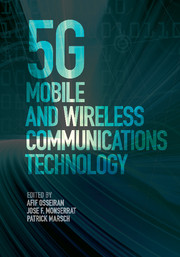Book contents
- Frontmatter
- Dedication
- Contents
- List of contributors
- Foreword
- Acknowledgments
- Acronyms
- 1 Introduction
- 2 5G use cases and system concept
- 3 The 5G architecture
- 4 Machine-type communications
- 5 Device-to-device (D2D) communications
- 6 Millimeter wave communications
- 7 The 5G radio-access technologies
- 8 Massive multiple-input multiple-output (MIMO) systems
- 9 Coordinated multi-point transmission in 5G
- 10 Relaying and wireless network coding
- 11 Interference management, mobility management, and dynamic reconfiguration
- 12 Spectrum
- 13 The 5G wireless propagation channel models
- 14 Simulation methodology
- Index
- References
4 - Machine-type communications
Published online by Cambridge University Press: 05 June 2016
- Frontmatter
- Dedication
- Contents
- List of contributors
- Foreword
- Acknowledgments
- Acronyms
- 1 Introduction
- 2 5G use cases and system concept
- 3 The 5G architecture
- 4 Machine-type communications
- 5 Device-to-device (D2D) communications
- 6 Millimeter wave communications
- 7 The 5G radio-access technologies
- 8 Massive multiple-input multiple-output (MIMO) systems
- 9 Coordinated multi-point transmission in 5G
- 10 Relaying and wireless network coding
- 11 Interference management, mobility management, and dynamic reconfiguration
- 12 Spectrum
- 13 The 5G wireless propagation channel models
- 14 Simulation methodology
- Index
- References
Summary
Introduction
Machine-Type Communication (MTC) denotes the broad area of wireless communication with sensors, actuators, physical objects and other devices not directly operated by humans. Different types of radio access technologies are targeting MTC (see [1]). For Long Term Evolution (LTE), it has emerged as an important communication mode during the recent standard evolution. The research and development efforts made to enhance LTE in a way to support MTC clearly indicate the need for the wireless system architecture to address MTC. As the role of MTC is expected to grow in the future, there is a good opportunity in the development of a 5G wireless system to address MTC from the very beginning in the system design.
This chapter is organized in the following way. Section 4.1 outlines some of the most important use cases for MTC and categorizes MTC into the groups of massive MTC (mMTC) and ultra-reliable and low-latency MTC (uMTC). The requirements for these two MTC categories are defined. Section 4.2 describes some fundamental techniques for MTC. Sections 4.3 and 4.4 address mMTC and uMTC respectively and explain the corresponding design principles and technology components. Section 4.5 summarizes the chapter.
Use cases and categorization of MTC
The general use case of low-rate MTC
MTC use cases exist in a wide range of areas. They are mainly related to large numbers of sensors monitoring some system state or events, potentially with some form of actuation to control an environment. One example is automation of buildings and homes, where the state e.g. of the lighting, heating, ventilation and air condition, energy consumption, are observed and/or controlled. There are also wide area use cases, such as environmental monitoring over larger areas, monitoring of some infrastructure (e.g. roads, industrial environments, ports), available parking spaces in cities, management of object fleets (e.g. rental vehicles/bicycles), asset tracking in logistics, monitoring and assistance of patients. There are use cases that comprise remote areas, such as in smart agriculture. In the context of the use cases described in Chapter 2, MTC appears as an important, if not the crucial, element in (1) autonomous vehicle control, (3) factory cell automation, (6) massive amount of geographically spread devices, (10) smart city, (12) teleprotection in smart grid network and (15) smart logistics/remote control of industry applications.
Information
- Type
- Chapter
- Information
- 5G Mobile and Wireless Communications Technology , pp. 77 - 106Publisher: Cambridge University PressPrint publication year: 2016
References
Accessibility standard: Unknown
Why this information is here
This section outlines the accessibility features of this content - including support for screen readers, full keyboard navigation and high-contrast display options. This may not be relevant for you.Accessibility Information
- 12
- Cited by
